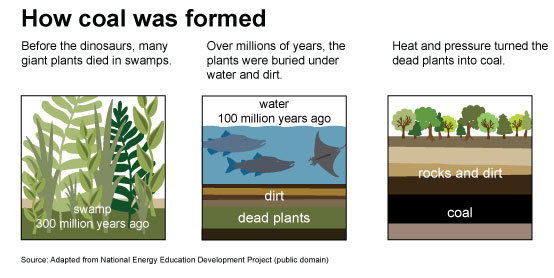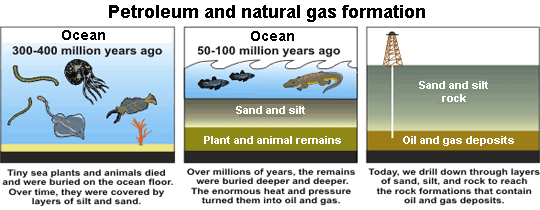Fossil fuels such as Coal, Oil and Gas are some of the most important natural resources that we use everyday. These fossil fuels are all Hydrocarbons, they are compounds formed from only two elements, Carbon and Hydrogen.
Fossil fuels are used to produce energy; in the home they are burned to produce heat, in large power stations they are used to produce electricity and they are also used to power engines. The bonds between the Hydrogen and Carbon atoms store energy, by burning the compounds in the presence of Oxygen the bonds are broken and the stored energy is converted to heat energy, forming Carbon Dioxide (CO2) in the process.
Fossil fuels are non-renewable, this means that their supply is limited and they will eventually run out. Fossil fuels formed from the decomposition of plants and animals from millions of years ago this is why they are called fossil fuels.
How does each form?
Hundreds of millions of years ago, even before the dinosaurs, there were huge plants and ferns that lived in swamp forests. When these plants and ferns died they decayed and formed layers at the bottom of the swamps. Water and soil built up on top of these layers and over thousands of years pressure and high temperatures would cause the decayed plants and ferns to undergo chemical and physical changes which pushed out the oxygen from the decaying layers. As the plants and ferns continued to decay in the absence of oxygen they formed coal.
 Coal formation stage. Source: U.S. Energy Information Administration
Coal formation stage. Source: U.S. Energy Information Administration
The oil and gas we use today was formed by the decay of microscopic plants and animals that lived in the ocean millions of years ago. As these plants and animals died they fell to the bottom of the ocean and formed layer after layer of sediment covered by sand and mud. In some areas where there is little tidal movement such as lakes or seas the plants and animals begin to decay in the absence of oxygen. As the layers build up the weight increases and the sediment is pushed further down, this increases both the temperature and pressure. With all of these factors combined the decayed plants and animals form oil and gas deposits.
In some cases these deposits rise to the surface and seep out into soil and water. In other cases the oil and gas deposits are trapped under impermeable layers of rock and drilling is necessary.
Natural gas consists mainly of Methane (CH4) but can also contain other gases such as Butane and Propane.
 Oil and gas formation stages. Source: U.S. Energy Information Administration
Oil and gas formation stages. Source: U.S. Energy Information Administration
Peat is a very young form of coal, if left for a long period of time peat will eventually form coal. Peat was formed by the decay of plants and in some cases trees. These plants accumulated and decayed over hundreds of thousands of years in waterlogged areas. Peat formed in areas where there was poor drainage. When the last ice-age ended and ice melted it left behind glacial features such as eskers and moraines. These features are evident in the topography of Ireland, especially the midlands, and lead to poor drainage of the soil. This poor drainage along with continual growth of vegetation, high levels of rainfall and a low levels of oxygen lead to the formation of peatlands..
How do we use fossil fuels?
Fossil fuels are burned to produce energy. In large power stations they are burned in the presence of oxygen. As the fuel burns the heat energy is used to heat water, as it is heated it produces steam which in turn rises and drives a turbine.
The energy conversion goes from chemical energy stored in the fuels, to heat energy as it burns which is converted to kinetic energy as it drives large turbines and finally this is converted to electrical energy.
The problem with burning fossil fuels is their effect on the environment. As mentioned fossil fuels are Hydrocarbons. When hydrocarbons are burned in the presence of oxygen they release carbon dioxide into the atmosphere. Carbon dioxide is a Greenhouse Gas and is a leading cause of Global Warming.
Chemical reaction of Methane (Natural Gas) burning in the presence of Oxygen showing the production of Carbon dioxide (CO2)
CH4 + 2O2 → CO2 + 2H2O
Fossil fuels are also used in the petrochemicals industry, here the fossil fuels are used to make plastics, paints and even medication.
Fossil fuels and Ireland
Ireland has a history of coal mining in areas of Leinster including Kilkenny, Carlow and Laois. The Arigna coal mine in Co. Roscommon opened in the late 18th century and ran up as far as the 1990's. Today Ireland imports most of its coal from areas such as Poland. The use of coal for production of electricity is decreasing as shale gas becomes more available.
Natural gas is widely used in Ireland with supplies coming from both Irish sources and imports. There are a number of gas fields in operation off the coast of Ireland including Kinsale Head, Ballycotton and the Seven Heads fields all located off the coast of County Cork. In recent years a new gas field located at Corrib off the west coast has been exploited. Having come on stream in late 2015 it is expected that it will meet 40% of the country's gas needs in its first two years before production starts to decline.
Oil is one of the world's most valuable commodities. In Ireland oil is no longer used for the production of electricity but is heavily relied on for transport and home heating. Ireland has no domestic oil production and depends entirely on imports.
In Ireland Peat has two main uses, generating electricity and home heating. Ireland has many raised bogs across the midlands. Bord na Móna is a commercial semi state company that is responsible for the mechanised harvesting of peat in Ireland. To prevent the destruction of Ireland's peatlands and their ecosystems many raised bogs and blanket bogs have been given legal protection and restrictions to peat harvesting have been put in place.
Related processes
There are several steps an energy source must go through before it becomes useful
First the energy source must be found, geologists are constantly studying areas and their rocks to determine if deposits or wells are likely to occur.
Once a source is located it then needs to be removed from the Earth. Extraction processes can vary from mining for coal, mechanical harvesting of peat and drilling for oil and gas.
Processing can take the form of crushing, grinding and milling. Coal is broken into smaller usable lumps for use in domestic settings and peat is often milled and compressed into briquettes for use in the home.
The oil that is pumped from the earth is extracted in the form of crude oil. This oil must be sent to a refinery where the different mixtures of fuels are separated by a processes called fractional distillation. The oil is separated into its different components such as petrol, diesel, kerosene, and residue. These components can be processed further to make plastics.